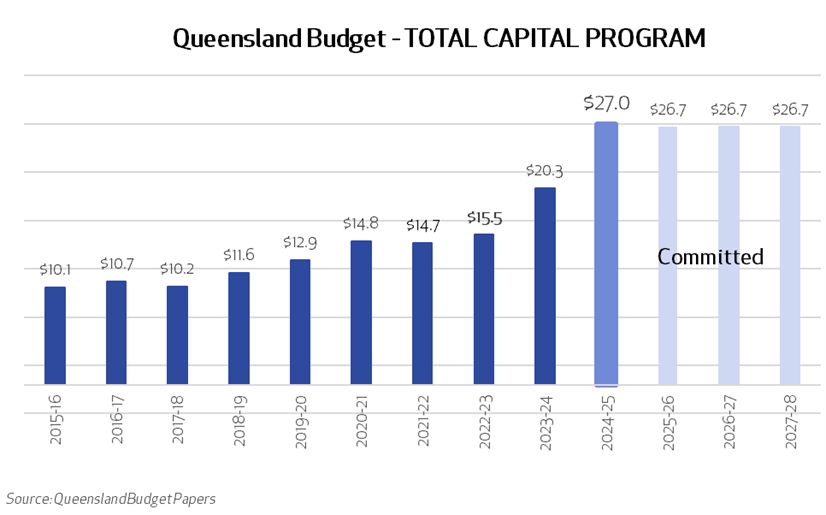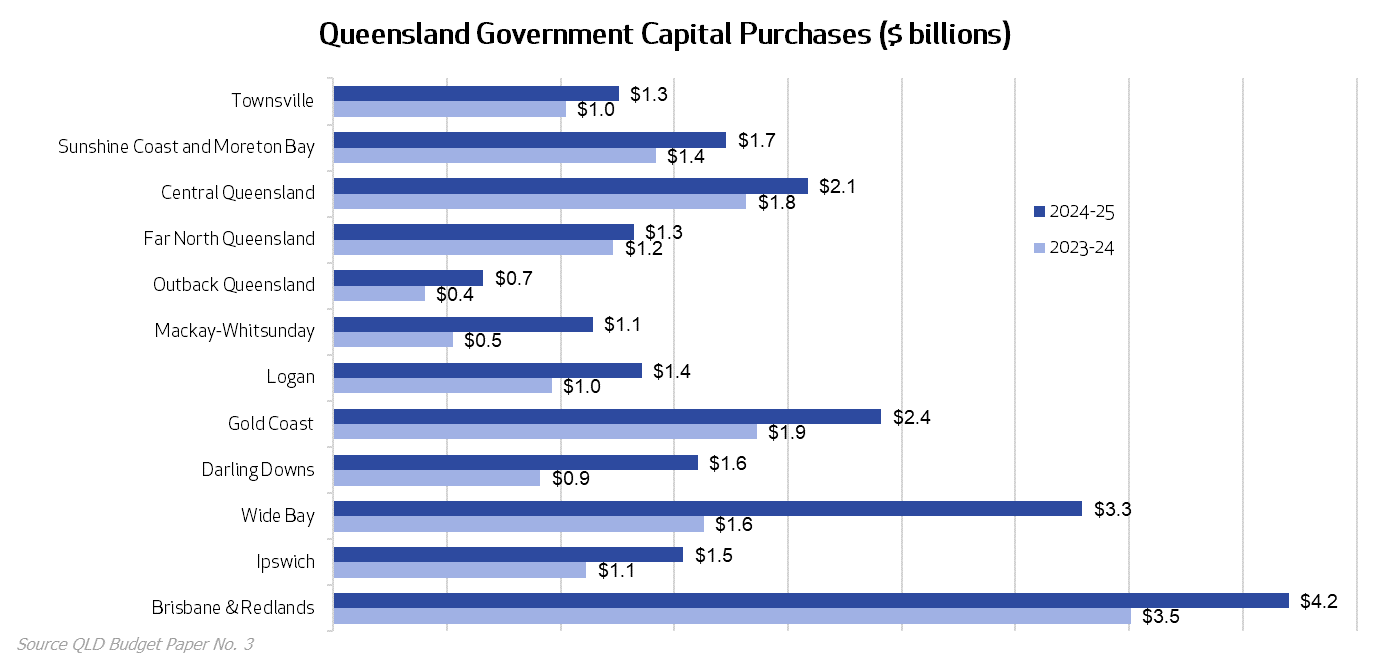Highlights for building and construction
The 2024 Queensland Budget commits to a $107 billion capital spend across the next four years.
The annual commitment, now $27 billion, has nearly doubled in just two years. This is a massive increase in the amount of work in the pipeline, placing more pressure on an industry already struggling to deliver the homes and infrastructure our communities need. Again driving up construction costs with trade shortages and falling productivity.
The Budget also highlights a $2 billion increase in the cost of delivering the government's own projects over two years (2023-24 and 2024-25). An immediate lever the government can pull to turn this around is applying their own Best Practice Industry Conditions more flexibly, ensuring their major projects and large high-rise unit developments can be delivered more affordably, while keeping safety and build quality at the top of the agenda.
The budget
There has been an increase in the first home buyer stamp duty threshold, adding to the doubling of the First Home Owner Grant which was announced last year. While we support these measures, the threshold for these is too low, potentially excluding first home buyers in some areas.
Funding for 600 modular homes is a step in the right direction, but misses much of the opportunity in industrialised construction to fast-track building new homes.
We’ve welcomed the government’s investment in more fee-free training places, and the $1,000 tools cashback for first-year apprentices. However, this Budget doesn’t provide support for businesses, many of them small and family-run, who need to pay their apprentices and provide crucial on-site training as they study.
The budget commits billions of dollars towards tackling Queensland’s housing crisis – but fails to pull the levers that could provide immediate relief without costing a cent. Government must also roll back the changes to National Construction Code 2022, which are driving up building costs without a clear benefit. We also maintain project trust accounts should be scrapped. They don’t protect payments in insolvency.
This year’s budget sees another significant increase to the capital program. $107 billion is now allocated over the next four years. An $18 billion increase on the $89 billion committed in last year’s budget which was also a significant increase on the year before.
For the coming financial year (2024-25) this means a capital allocation of $27 billion; 33 per cent up on last year.

Much of the increased spend will be directed to energy transmission and generation with an investment of an additional $3 billion, taking the total to $8.7 billion over 2024-25.
Transport attracts the largest capital spend at $8.7 billion over 2024-25.
Health is another major focus with $2.2 billion allocated over 2024-25 towards the construction of three new hospitals (Bundaberg, Coomera, and Toowoomba) and the expansion of 12 other facilities.
Housing continues as a key area for government support. Funding has been increased to $3.1 billion under the government’s ‘Homes for Queenslanders’ plan. Funding includes $2 billion for the government’s Housing Investment Fund to boost affordable housing and to begin to fund the construction of 53,500 social homes by 2046.
There is also $350 million to incentivise infill development and a new state facilitated development team to streamline planning decisions.
Spending is now well underway for the Brisbane 2032 Olympic and Paralympic Games with $7.1 billion allocated over the next nine years.
High priority disaster resilience and mitigation projects will receive $100 million over three years.
Regional spending highlights
The proportion of major project funding that is allocated to the regions has increased again and is now evenly split with South East Queensland.
The largest shifts are to Mackay & Whitsunday, Wide Bay, and Darling Downs.

Some of the key projects include:
- Stage 1 of the Direct Sunshine Coast Rail Line ($2.8 billion contribution)
- Rockhampton Ring Road ($1.7 billion)
- Stage 3 of the Gold Coast Light Rail ($713 million contribution)
- Lotus Creek Wind Farm ($500 million)
- Cairns health infrastructure ($475 million)
- Fitzroy to Gladstone Pipeline ($311 million)
- Toowoomba to Warwick Pipeline ($273 million)
- Cairns Marine Precinct ($180 million)
- Townsville University Hospital Expansion ($136 million)
- Gladstone Northern Land Expansion for renewable energy projects ($34 million)
- Palmview State Secondary College ($15.7 million)
- Hervey Bay and Bundaberg police station upgrades ($15 million)
- Tiaro Bypass for the Bruce Highway ($5.6 million)
For a full list of all projects in each region, visit the government’s budget website.
Key government forecasts
- The Queensland’s economic growth is forecasted to remain consistent growing by 3 per cent in 2024–25 and then 2.5 per cent in 2025–26.
- The unemployment rate is forecast to edge higher, but stay low by historical standards, at 4.5 per cent in 2024–25 and 4.75 per cent in 2025–26.
- Queensland’s population growth increased to 2.5 per cent in 2023–24, reflecting a pickup in overseas migration. However, with migration forecast to stabilise at pre-pandemic levels, the government forecasts population growth to ease back to 1.5 per cent by 2024–25.
Opposition’s Reply
The state opposition’s Budget in Reply focused on addressing the housing crisis.
There was a pledge to deliver one million homes by 2044. This equates to 50,000 homes a year – another target for the building and construction industry.
To deliver on this goal the Liberal National Party of Queensland (LNP) pledged to:
- Establish a ministerial taskforce, with a regulatory review of the building industry as its first order of business. A great start if it results real and practical change.
- Abolish stamp duty for first home buyers building their first home, which will open up the market for more Queenslanders, and deliver work for our industry.
- A shared equity scheme offering up to 30 per cent equity in new homes, and 25 per cent for existing homes, for those who have at least two per cent of their deposit saved up, will also help people into new homes.
- $2 billion infrastructure fund over four years as a catalyst for new development to get housing built.
- Address the skills shortage by working with TAFE and registered training providers to ensure more people finish what they start.
- Assist small businesses by simplifying the tender process for government projects.





